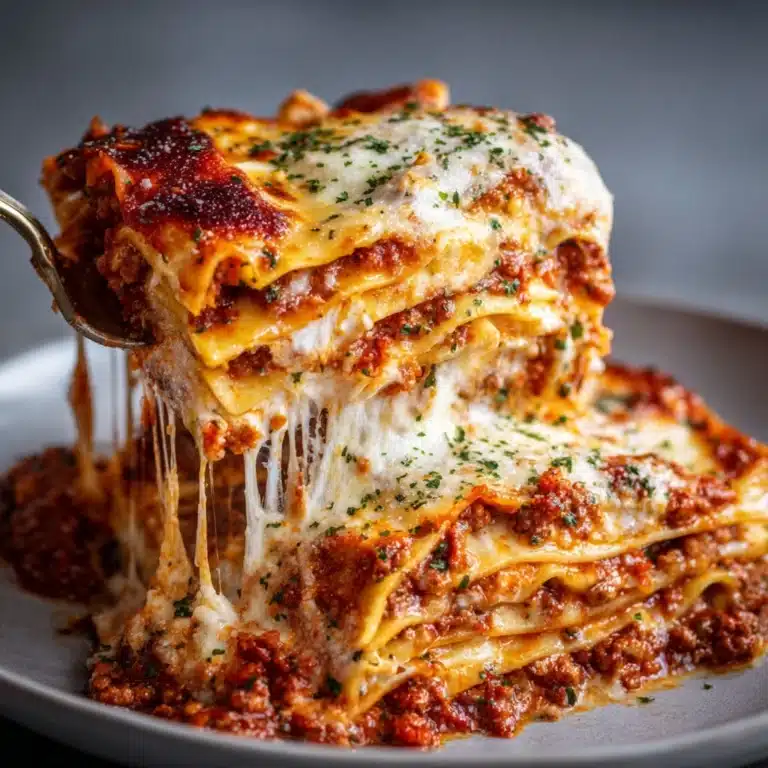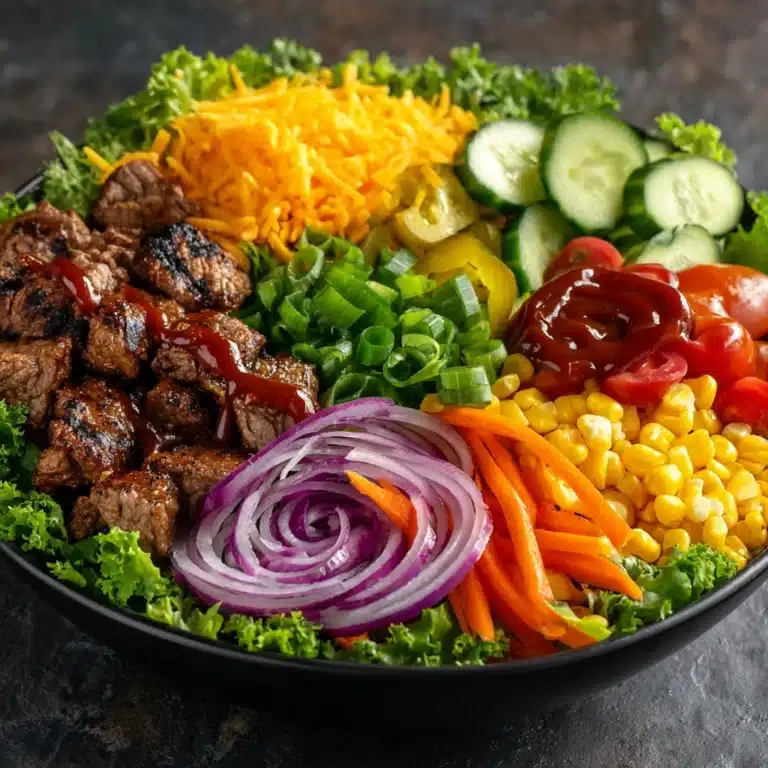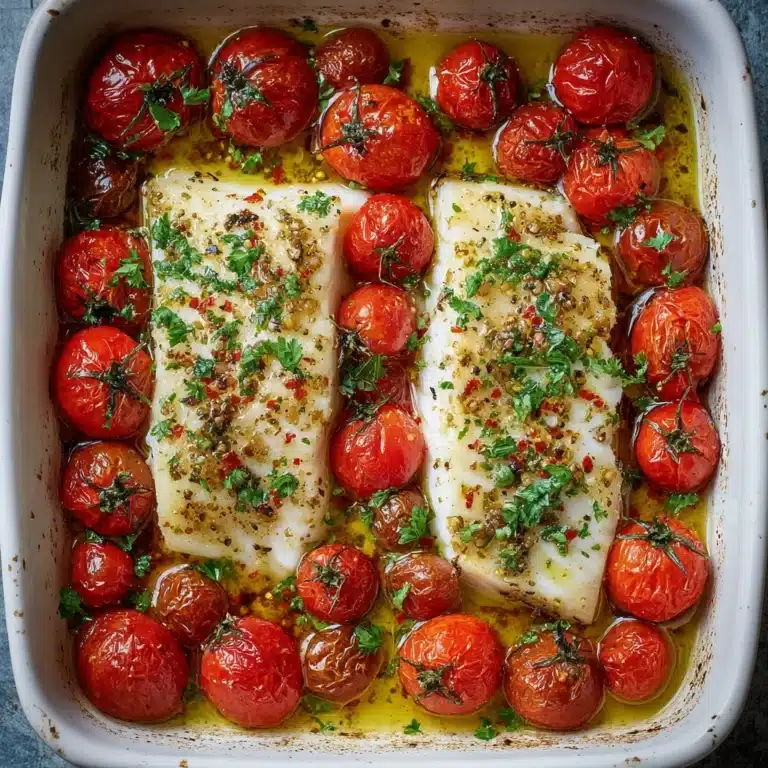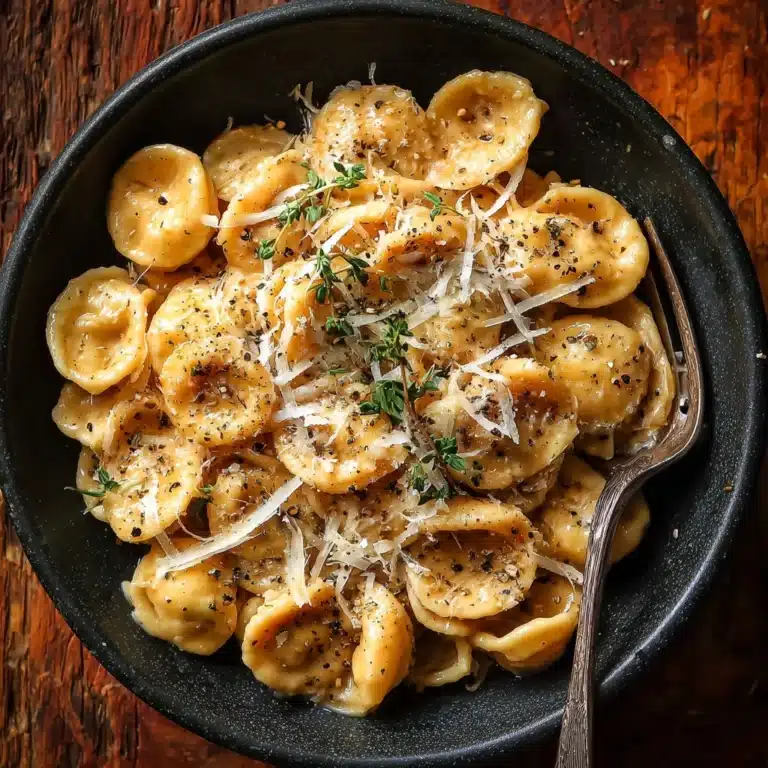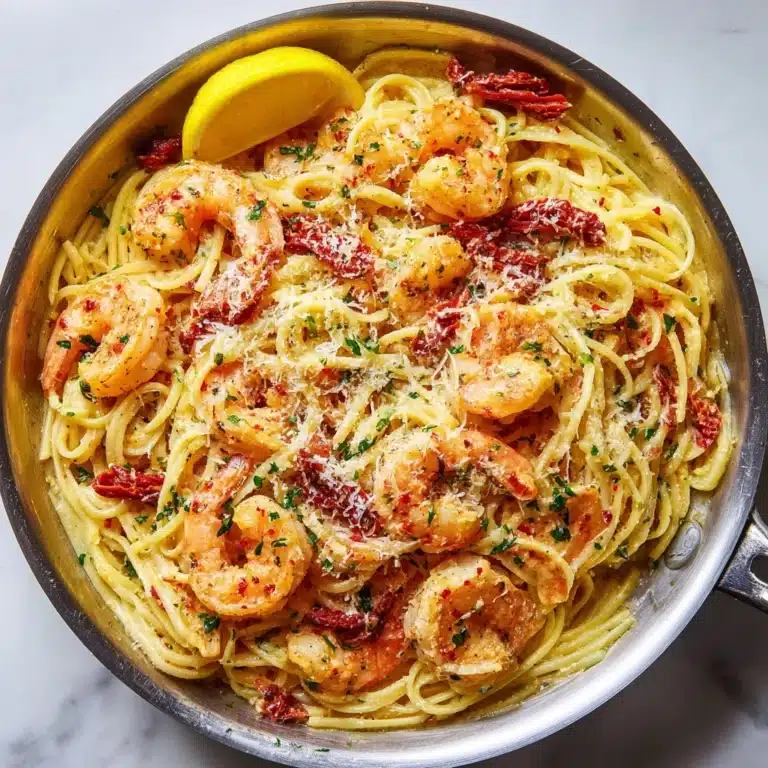High Protein Beijing Beef Rice Bowls Recipe
Craving something savory, satisfying, and loaded with flavor? Look no further than these High Protein Beijing Beef Rice Bowls. Packed with tender strips of beef, colorful vegetables, and a glossy Beijing-style sauce, this bowl is a powerhouse of protein that doesn’t skimp on comfort or taste. With a sweet-tangy sauce that hugs every bite, plenty of fresh crunch, and a bed of fluffy rice, it’s a weeknight-friendly dinner you’ll want to make over and over.
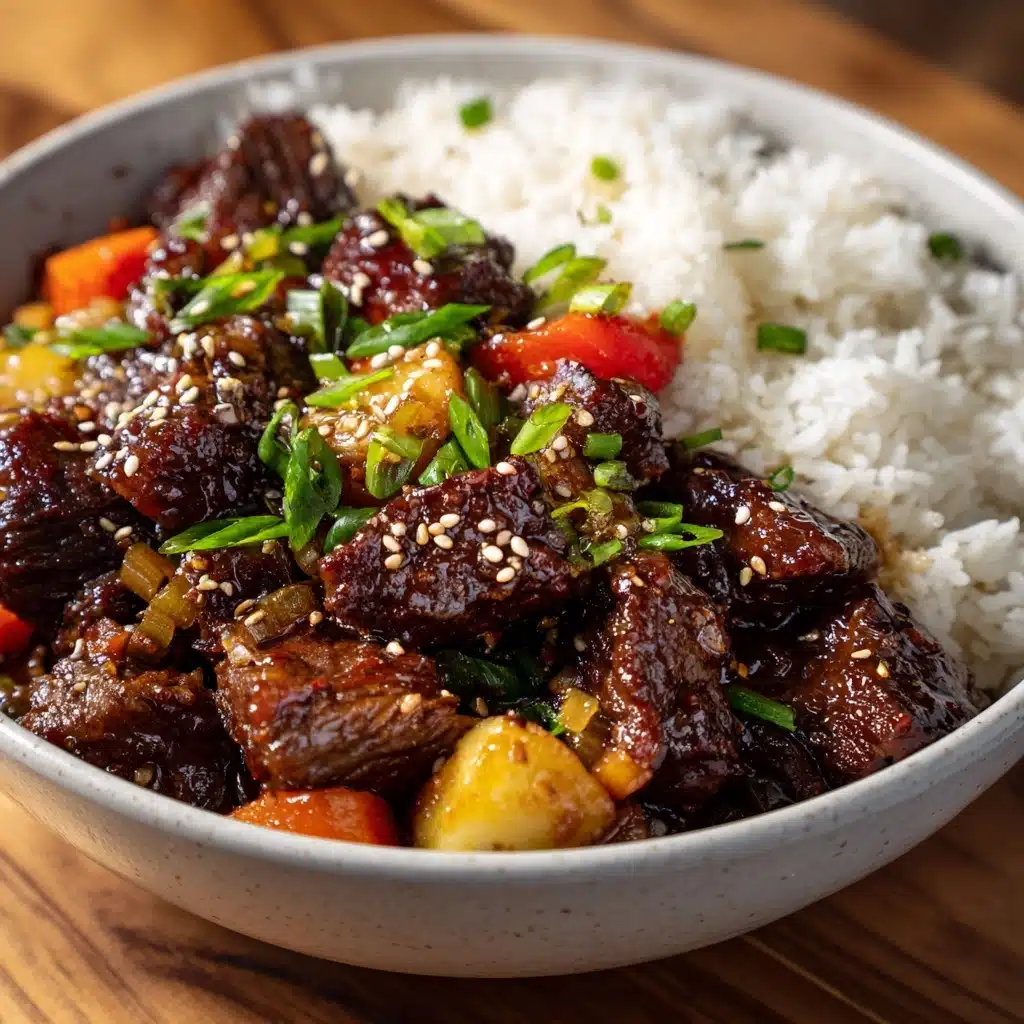
Ingredients You’ll Need
The magic in High Protein Beijing Beef Rice Bowls comes from a handful of simple, bold ingredients you probably already have. Each one plays a key role in the final result, adding everything from juicy texture to aromatic depth.
- Beef (flank steak or sirloin): Thin-sliced beef is the protein star, soaking up tons of sauce and staying juicy from the quick stir-fry.
- Cornstarch: A quick toss in cornstarch gives the beef that signature velvety crust and helps thicken the sauce later.
- Soy Sauce: Salty, umami goodness to both marinate the beef and season the sauce.
- Oyster Sauce: Adds a glossy body and subtle sweetness to the Beijing-inspired sauce.
- Hoisin Sauce: Brings unmistakable savory-sweet flavor that balances the dish.
- Rice Vinegar: Lifts everything with just the right amount of acidic brightness.
- Honey: For that glossy coating and hint of natural sweetness.
- Ketchup: The secret ingredient for tang and color that’s key to Beijing-style sauce.
- Chili Paste or Sriracha (optional): Kicks up the heat just a touch—you can leave it out if you prefer mild.
- Beef Broth: Rounds out the sauce and deepens the umami flavor.
- Vegetable Oil: Ensures a fast, even stir-fry without sticking.
- Red and Green Bell Pepper: Crunchy, colorful veggies that soak up the sauce beautifully.
- Onion: Sliced onions add sweetness and a bit of bite to the stir-fry.
- Garlic: Freshly minced for aromatic punch—don’t skimp!
- Fresh Ginger: Grated ginger offers gentle heat and complexity.
- Cooked Rice (brown or jasmine): The hearty, comforting base for your beef and sauce.
- Green Onions: A handful of fresh sliced scallions gives great color and a savory finish.
- Sesame Seeds: Just a sprinkle adds nutty crunch and beautiful garnish.
How to Make High Protein Beijing Beef Rice Bowls
Step 1: Prepare the Beef
Start by slicing your flank steak or sirloin into very thin strips against the grain—this little detail keeps the beef perfectly tender. In a bowl, toss them with cornstarch and a splash of soy sauce. The cornstarch creates that irresistible, silky texture you love in restaurant stir-fry, while the soy sauce starts infusing flavor from the very first step.
Step 2: Whisk the Beijing Sauce
Grab another bowl and bring together oyster sauce, hoisin sauce, rice vinegar, honey, ketchup, chili paste, beef broth, and the last of the soy sauce. Whisk until smooth. This mixture is the heart and soul of your High Protein Beijing Beef Rice Bowls, hitting every note: snappy, sweet, a bit spicy, and full of umami.
Step 3: Stir-Fry the Beef
Heat up a wok or large skillet on high, swirled with vegetable oil. Add the beef in batches (don’t crowd the pan) and sear for 2 to 3 minutes, just until browned and cooked through. Quick cooking locks in those juices. Scoop the beef onto a plate to rest while you continue.
Step 4: Sauté the Veggies
In the same pan, toss in your bell peppers, onion, garlic, and ginger. Keep things moving—the goal is crisp-tender veggies that light up the bowl with sweetness and fresh crunch. This takes just about 4 minutes.
Step 5: Bring It All Together
Return the cooked beef to the skillet along with your whisked Beijing sauce. Toss everything together over high heat and watch as the sauce bubbles, thickens, and coats each piece of beef and veggie. Give it 2 to 3 minutes, then you’re ready to build your bowls.
Step 6: Serve Over Rice
Spoon generous helpings of hot cooked rice into bowls, top with the vibrant beef and veggies, and don’t forget a bit of extra sauce from the pan. Finish with a sprinkle of green onions and a scattering of sesame seeds for true takeout vibes.
How to Serve High Protein Beijing Beef Rice Bowls
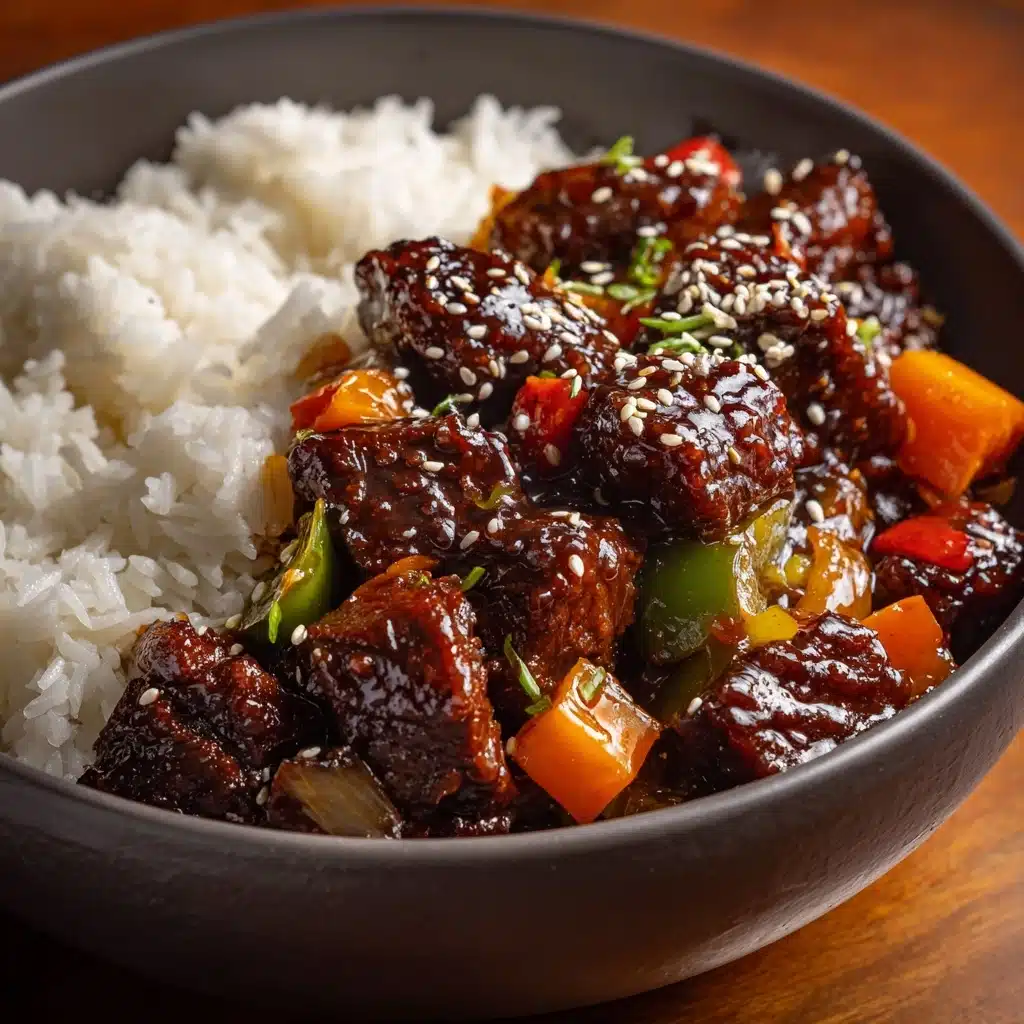
Garnishes
For a picture-perfect finish, I love to shower each bowl with freshly sliced green onions and a sprinkle of toasted sesame seeds. If you’re feeling bold, a drizzle of extra chili sauce and a few threads of red chili add both color and spice flair. These toppings bring out the best in each bite and make your High Protein Beijing Beef Rice Bowls totally restaurant-worthy.
Side Dishes
While these bowls pack plenty of flavor on their own, they pair beautifully with simple sides like steamed bok choy, crisp cucumber salad, or even a quick miso soup. If you want to bump up the protein and freshness even more, add a handful of edamame or a poached egg on top—these additions fit seamlessly with the style of High Protein Beijing Beef Rice Bowls.
Creative Ways to Present
Some nights call for a classic bowl, other nights you may want to break the routine. Try serving your beef mixture over cauliflower rice for a lighter twist, or pile everything into lettuce wraps for a fresh, hand-held version. Even using quinoa or farro as the base gives a modern spin that’s still in the spirit of High Protein Beijing Beef Rice Bowls.
Make Ahead and Storage
Storing Leftovers
Store any leftover beef and veggies (separate from the rice if possible) in airtight containers in your fridge. This helps the flavors stay bold and the veggies crisp. High Protein Beijing Beef Rice Bowls are just as delicious the next day, and the sauce will soak into everything even more.
Freezing
For meal prep fans, the beef and sauce freeze well for up to two months. Let portions cool completely, then freeze in airtight bags or containers. When you’re ready for a bowl, thaw overnight in the fridge and simply reheat. It’s smart planning for those busy weeknights you still want something hearty.
Reheating
To reheat, warm the beef and veggies gently in a skillet over medium heat, adding a splash of water or broth to loosen the sauce if needed. Microwave works in a pinch too—just use a glass bowl with a loose-fitting lid to prevent drying out. Add fresh green onion and sesame seeds after reheating to recapture that just-cooked vibrance.
FAQs
Can I use a different cut of beef?
Absolutely! While flank steak or sirloin delivers the perfect tenderness and soak up the sauce beautifully, you can substitute with skirt steak or even thin-sliced ribeye. Just keep the beef thin so it cooks quickly and stays tender.
Can I make the High Protein Beijing Beef Rice Bowls gluten-free?
Yes! Choose gluten-free soy sauce (also known as tamari) and double-check your oyster and hoisin sauce labels for gluten-free certification. The rest of the ingredients are naturally gluten-free, so you can enjoy these bowls without worry.
What if I want to add more veggies?
Go for it! Snow peas, carrots, baby corn, or broccoli all work well here. Just slice everything bite-sized and stir-fry along with the peppers and onion, adjusting cook time as needed to keep them crisp.
Is there a way to make this spicier?
Of course. Increase the chili paste or sriracha in the sauce, or add a sprinkle of chili flakes during stir-frying. You can also serve extra hot sauce or sliced chilies at the table so everyone can dial up the heat to their liking.
Can I meal prep these bowls in advance?
Definitely! Make the beef and sauce ahead of time, store them in the fridge, and reheat as needed. The rice can be pre-cooked and quickly warmed, or you can portion everything into containers for grab-and-go lunches. High Protein Beijing Beef Rice Bowls are perfect for prep and stay fresh for several days.
Final Thoughts
There’s something incredibly comforting (and exciting!) about digging into a home-cooked High Protein Beijing Beef Rice Bowl. Every bite delivers big flavor, lots of texture, and a hit of nourishing, crave-worthy protein. Whether you’re feeding a family or just yourself, this is the kind of recipe that brings a taste of takeout magic into your kitchen—don’t miss out! Let these bowls become your new favorite weeknight staple.
Print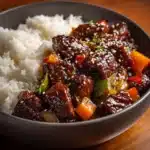
High Protein Beijing Beef Rice Bowls Recipe
- Total Time: 40 minutes
- Yield: 4 servings 1x
- Diet: Non-Vegetarian
Description
These High Protein Beijing Beef Rice Bowls are a delicious and satisfying meal that brings the flavors of Chinese takeout right to your dinner table. Tender slices of beef are stir-fried with colorful bell peppers, onions, and a savory Beijing sauce, then served over hot rice and garnished with green onions and sesame seeds.
Ingredients
For the Beef:
- 1 1/2 pounds flank steak or sirloin, thinly sliced
- 3 tablespoons cornstarch
- 3 tablespoons soy sauce, divided
For the Beijing Sauce:
- 2 tablespoons oyster sauce
- 2 tablespoons hoisin sauce
- 2 tablespoons rice vinegar
- 2 tablespoons honey
- 2 tablespoons ketchup
- 1 teaspoon chili paste or sriracha (optional)
- 1/2 cup beef broth
For Stir-Fry:
- 2 tablespoons vegetable oil
- 1 red bell pepper, sliced
- 1 green bell pepper, sliced
- 1 small onion, sliced
- 3 cloves garlic, minced
- 1 teaspoon fresh ginger, grated
For Serving:
- 4 cups cooked brown rice or jasmine rice
- 1/4 cup green onions, sliced
- 1 tablespoon sesame seeds
Instructions
- Prepare the Beef: Toss sliced beef with cornstarch and 1 tablespoon soy sauce.
- Make the Beijing Sauce: Whisk together oyster sauce, hoisin sauce, rice vinegar, honey, ketchup, chili paste, beef broth, and remaining soy sauce.
- Stir-Fry: Heat vegetable oil in a skillet, stir-fry beef until browned, remove. Stir-fry bell peppers, onion, garlic, and ginger. Return beef, add Beijing sauce, cook until thickened.
- Serve: Over hot rice, garnish with green onions and sesame seeds.
Notes
- For extra protein, add a fried or poached egg on top of each bowl.
- To keep this lighter, swap in cauliflower rice or quinoa.
- Prep Time: 20 minutes
- Cook Time: 20 minutes
- Category: Main Course, Rice Bowl
- Method: Stir-Frying
- Cuisine: Asian-American, Chinese-Inspired
Nutrition
- Serving Size: 1 bowl
- Calories: 610
- Sugar: 16 g
- Sodium: 940 mg
- Fat: 22 g
- Saturated Fat: 7 g
- Unsaturated Fat: 13 g
- Trans Fat: 0 g
- Carbohydrates: 62 g
- Fiber: 4 g
- Protein: 42 g
- Cholesterol: 105 mg
